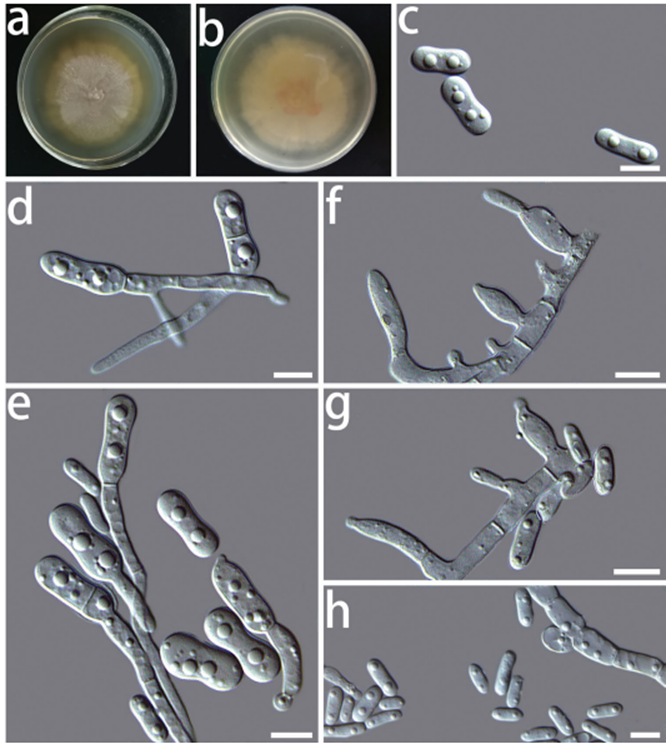 102
102
Coniochaeta fibrosae H. L. Si & Y. M. Su, sp. nov.2021
MycoBank No: 839390
Holotype. China, Yunnan Province: Tiesuo township, 26°32'71"N, 100°57'3"E, ca. 2120 m elev., isolated from Candelaria fibrosa, 13 Nov 2020, H. L. Si, CX03C1 (HMAS 350271, holotype), ex-type culture CGMCC3.20304.
Morphological description :
Asexual morph: . Colony on PDA after 8 d, hyphae hyaline, multi-guttulate, septate, smooth-walled; conidiophores short; conidiogenous cells hyaline, phialidic or oval in shape, single or in clusters on short lateral branches, measuring 2.9–7.2 × 1.8–3.7 μm (x–= 4.7 × 2.6 μm, n = 50) (Fig. 2f, g); two types of conidia were observed, swollen conidia were hyaline, one-celled, dumb-bell-shaped, with hyphae emerging from both ends (Fig. 2d, e), measuring 7.6–16.5 × 2.3–4.1 μm (x– = 9.7 × 3.1 μm, n = 50) (Fig. 2c), oblong conidia were hyaline, one-celled, often oblong to ellipsoidal in shape, measuring 3.4–6.8 × 1.4–2.7 μm (x– = 4.7 × 1.8 μm, n = 50) (Fig. 2h). Chlamydospores absent.
Sexual morph unknown.
Culture characteristics. The optimal temperature for growth was 25 °C on PDA. No growth was detected at 5 and 35 °C. Colonies on PDA after 8 d at 25 °C were white, circular, margin entire, flat, dense, partially immersed in the medium and sticky protuberance at the centre of the colony.
Habitat: isolated from on Candelaria fibrosa,
Distribution: . China, Yunnan Province: Tiesuo township
GenBank: lsu MW750758; its MW750760. Lsu MW750755 ; its MW750756.
Notes: In the phylogenetic analyses, both isolates of C. fibrosae sp. nov. formed a monophyletic clade, but the sister taxon differed between datasets. These sibling species were either C. boothii (ITS) or C. pulveracea (LSU and concatenated). Both of these sibling species were described, based on their sexual state and chlamydospores (Manoharachary and Ramarao 1973; Romero et al. 1999; García et al. 2006). However, we did not find sexual reproductive structures in our species. As a result, we were unable to compare the morphology of these species.
Reference: [1] Limkaisang, S. , Kom-Un, S. , Furtado, E. L. , Liew, K. W. , Salleh, B. , & Sato, Y. , et al. (2005). Molecular phylogenetic and morphological analyses of oidium heveae, a powdery mildew of rubber tree. Mycoscience, 46(4), 220-226.
 Morphological characters of Coniochaeta fibrosae sp. nov. (HMAS 350271) a, b cultures on PDA from the surface and reverse c swollen conidia d, e swollen conidia germinate hyphae f, g conidiogenous cells h conidia. Scale bars: 10 μm
Morphological characters of Coniochaeta fibrosae sp. nov. (HMAS 350271) a, b cultures on PDA from the surface and reverse c swollen conidia d, e swollen conidia germinate hyphae f, g conidiogenous cells h conidia. Scale bars: 10 μm

